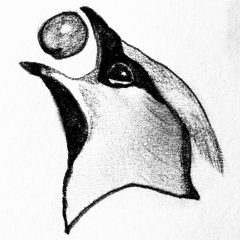
From the outset we were dressed in kilts at every opportunity. This didn’t much bother us, being junior patriots; except when it came to parties. It was not cool to attend those in highland dress. You can’t do a convincing Twist or Shake when you look like a miniature Andy Stewart. My parents once sent me to a children’s party at a farm south of Dunure on the Ayrshire coast dressed as illustrated above. At age nine, I was the youngest guest and the only one in a kilt. Complicated party games ensued that I didn’t really understand. The Beatles had just released I Want to Hold Your Hand. One of the older boys kept sneaking over to the record player to put it on. Relief washed over me when my parents eventually arrived to take me home. My mother was irritated, ‘You needn’t have looked so pleased to see us!’ she said, once we were in the car.
Our first kilts were hand-me-downs from our older girl cousins and had secret white sleeveless bodices sewn onto them. This was useful for keeping the lower edge of ones kilt at knee-level – but a bit warm. The tartan (or sett) was Ancient Murray of Atholl because my paternal grandmother was a Murray. Our family surnames were otherwise all Lowland Scots: Stevenson, Walker, Meikle and Black. These days there’s a tartan for every name or institution.
I suppose we all bought into the Victorian fantasy of the clans. In reality, tartans were originally just the type of woollen cloth woven in a given area before the ‘tartaning’ of Scotland really got going. Most plaids were a simple grey colour. In A Man’s a Man For a’ That (1795) Burns refers to ‘hodden grey’, that being the simplest, cheapest, type of cloth woven from a mixture of black and white wool. White predominated in the proportion 12:1.
Underneath our kilts we wore what Mum referred to as ‘trews’ – which were sort of underpants made of dark green wool and not at all like the trews I would later wear with black tie.
My mother considered kilts mandatory for all family and social occasions and I suppose we did look quite presentable. As my father was a director of the Royal Highland Society there was a three-line whip for kilts at the Highland Show. This was held in June at the Ingliston show ground west of Edinburgh. For the duration of hostilities we stayed with my grandparents at Eskbank. Dad, favoured a light tweed suit – I never saw him in highland dress. With his fancy director’s badge pinned to the left lapel like a medal, he would set off very early in the morning, a big D (for Director) Car Park Sticker attached to the windscreen of the Jaguar. We would follow on later with Mum, Granny and Grandad.
Despite Edinburgh being on the east coast of Scotland, the show ground could be warm in June and the thick wool kilts coupled with Pringle jumpers and tweed jackets were stifling. If you were with the womenfolk you were doomed to meet their friends and your more obscure relatives every few strides. It was never very clear to me who these people were. We were repeatedly greeted with, ‘These must be the boys!’ then asked our names, our age, and what we were doing at school. We were told how nice we looked in our kilts.
As the eldest, I soon learned to escape this social quicksand by going off with my grandfather. He had been a breeder of Shorthorn cattle and Clydesdale horses and together we would inspect the stock lines and watch the judging in the ring. Grandad, in a grey suit with heavy brogue shoes soled in leather and armoured with metal segs, leaned on his stick and scrutinised the animals from under his bonnet without a word. When he did meet old farming friends, their exchanges were laconic to a fault. It was infinitely preferable to meeting the mystery relatives.
In those days, many farmers at the show carried a stick, often a shepherd’s crook with a carved horn handle. My dad had a rather exotic-looking light cane number which he mostly carried hooked over his left arm. Many of the women sported leather shooting sticks for sitting on during long conversations. For the rest of the year these implements languished in the hall cupboard.
Plaide is gaelic for blanket and feileadh means wrap. The feileadh-mor or great kilt was a huge length of wool cloth that was gathered roughly into pleats and laid on the ground on top of a large leather belt. The wearer then lay down on the cloth and wrapped it around himself, securing the garment with the belt and covering his upper body with the remaining length of plaid. In the early 19th century the modern tailored short kilt, the feileadh beag (little wrap) was developed. The term was anglicised to philabeg or filibeg. This style of garment became the kilt worn by Scottish regiments.
My kilt-wearing stopped when I went to secondary school. Philabegs were by then deeply unfashionable and expensive to replace as we outgrew them. In any case, we no longer wished to wear the kilt. Later, at Edinburgh University in the seventies, commando jackets and patched flared jeans with desert or cowboy boots were de rigueur. An Afghan coat was the ultimate in fashion if you could afford one. My cowboy boots were bought in Greyfriars Market in Forrest Road and, incongruously, made in Czechoslovakia. They were perfect for long strenuous events, like attending the Tron Kirk on New Year’s Eve. The heels raised you that bit higher to help you keep track of your pals in the vast crowd, and you could crunch over the broken glass around the Heart of Midlothian with impunity.
Lacking any sort of smart clothes during this era, my mother had me measured for a three-piece pinstripe suit at a local gentleman’s outfitters. I insisted on huge lapels, a tight waistcoat and flared trousers with big turn-ups. The latter brushed the ground even when worn with my thick platform-soled ankle boots with their bulbous toes. I only ever remember wearing that suit for family funerals. When I went to my first medics’ ball I had to hire a dinner jacket and was very disappointed with the rather cheap material and unfashionable cut.
In the Eighties and Nineties we all smartened up. This was the era of Wall Street and Gordon Gekko. I had already cut my long hair and shaved off the beard although I kept the moustache for a while. I bought suits, coats and leather jackets, which all had big padded shoulders. I wore braces with my trousers and sported black lacing shoes with leather soles. A Russian friend had given me some advice; ‘All suits, shirts and ties are basically the same. The only thing a man should spend his money on is his watch and his shoes.’ For formal wear I bought a very nice Italian-made dinner jacket out of Austin Reed. It was double-breasted with sensible lapels and fitted me perfectly. Highland dress could not have been further from my mind.
No one of my age foresaw the resurgence of Scottish national dress that followed. Suddenly weddings, balls and rugby matches went full tartan. Until then, for formal occasions, I had worn my dinner jacket – but now I perceived I had a wardrobe gap, and took myself off to Kinloch Anderson for a fitting.
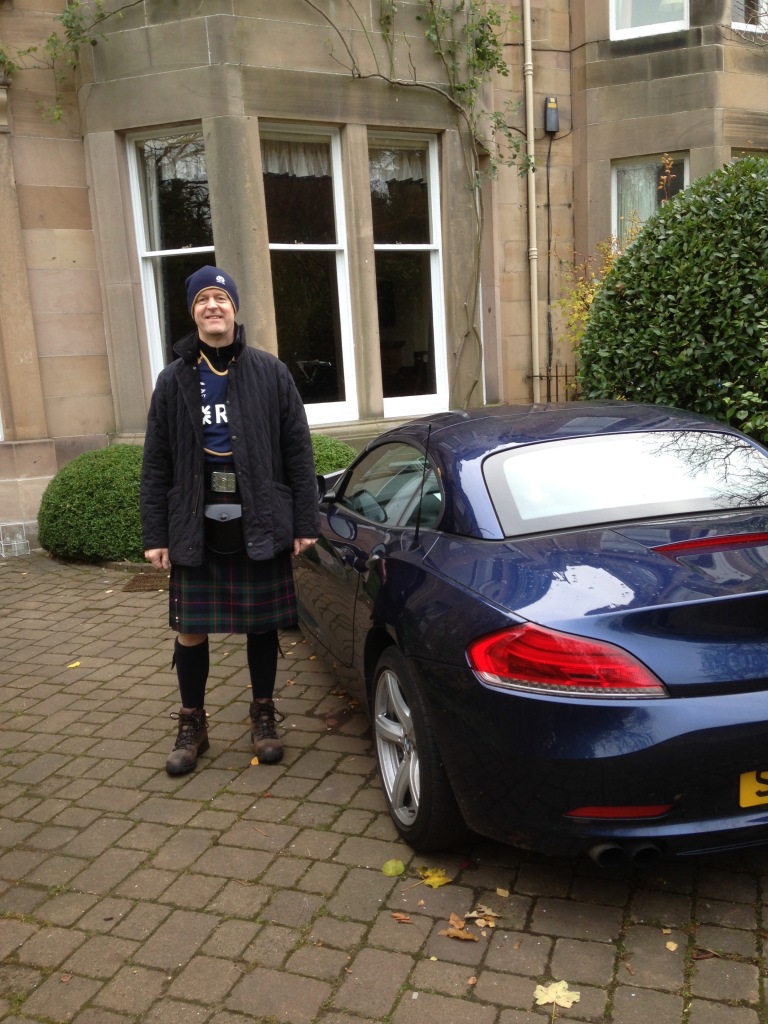
KA didn’t get those Royal Warrants for undercharging, but it was reassuring – as I contemplated such a large investment – to be expertly dealt with. I was measured for a kilt and a pair of proper trews. For the sett, I opted for Modern Murray of Atholl because it was darker and more formal-looking than the washed-out tartan of my childhood.
Naturally, I needed a ‘coatee and vest’ for evenings and a tweed Jacket and waistcoat for day-wear. Then I had to choose two sporrans; a leather one for daytime and a furry one with a silver ‘cantle’ for formal occasions. I also had to have special socks and a skian dhu to tuck down one of them. I needed a big belt with a big buckle for ceilidhs, when you would wear just a shirt – and then there was the vexing question of what design of kilt pin to get. On and on it went. At least I already owned dress shirts, a black bow tie, cufflinks and dress studs. I also had a pair of decent black brogues and thus managed to sidestep getting the peculiar ghillie variety with all the holes and those long laces.
Initially I was very pleased with my new rig-out and wore it on the flimsiest of excuses – not just Burns Night. I have to say that my friends, some of whom had not fully emerged from the hippie years, did not share my enthusiasm. In fact, one or two considered it very FUNNY.
Soon after my spending spree at Kinloch Anderson, a trip to Rome for the Six Nations was mooted by some younger colleagues. Unlike me, these boys were well-used to wearing the kilt and did so at every opportunity. The four days of that visit were the longest continuous time I’ve dressed in a kilt. Having left home without any trousers there was no alternative. Our outfits gave us an undeserved celebrity in the Eternal City and I lost count of how often out hosts asked for photographs.
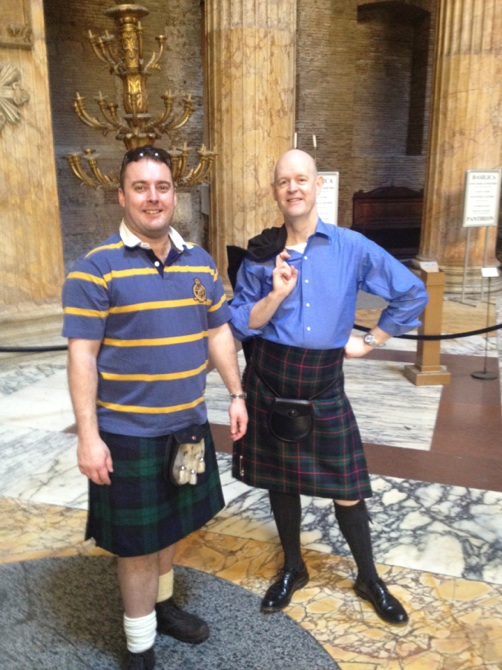
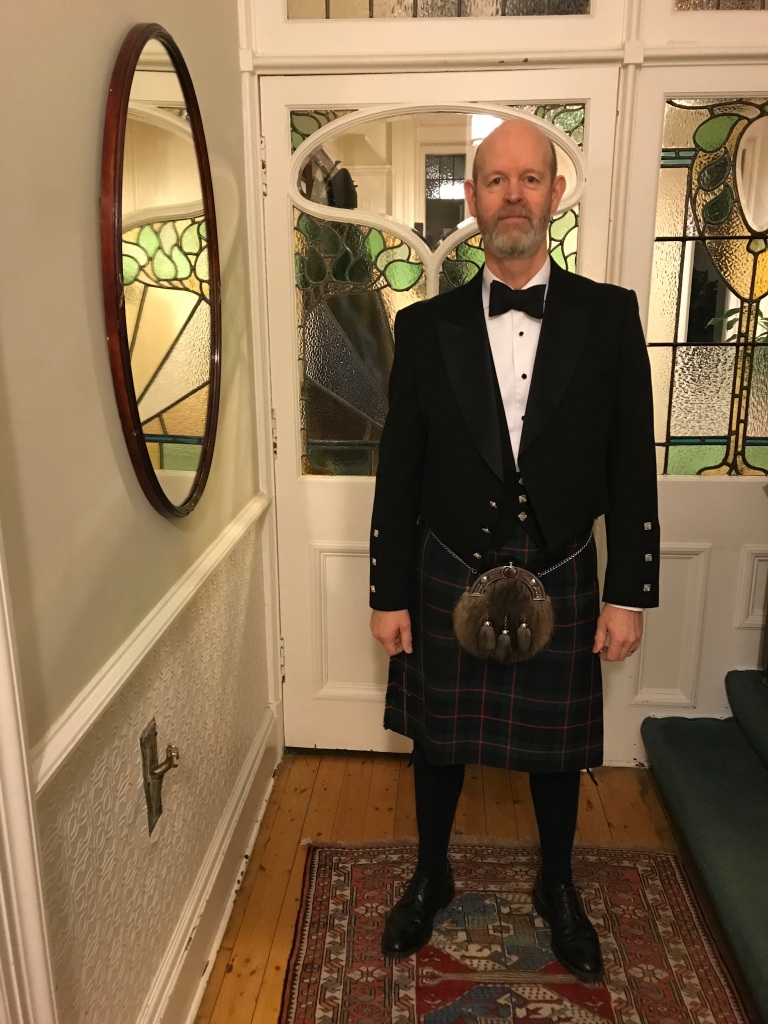
Most of the time I wore the kilt for formal occasions rather than sporting events, but my enthusiasm for the philibeg had decayed. I had already substituted trews with Chelsea boots for those occasions when I would once have worn a dinner jacket. In any case, to my great regret, the moths had eaten my DJ. Trews are more comfortable and practical than a kilt, and I was told that officers and gentlemen wore trews because they had horses to ride. Kilts were for the foot soldiers and the ghillies.
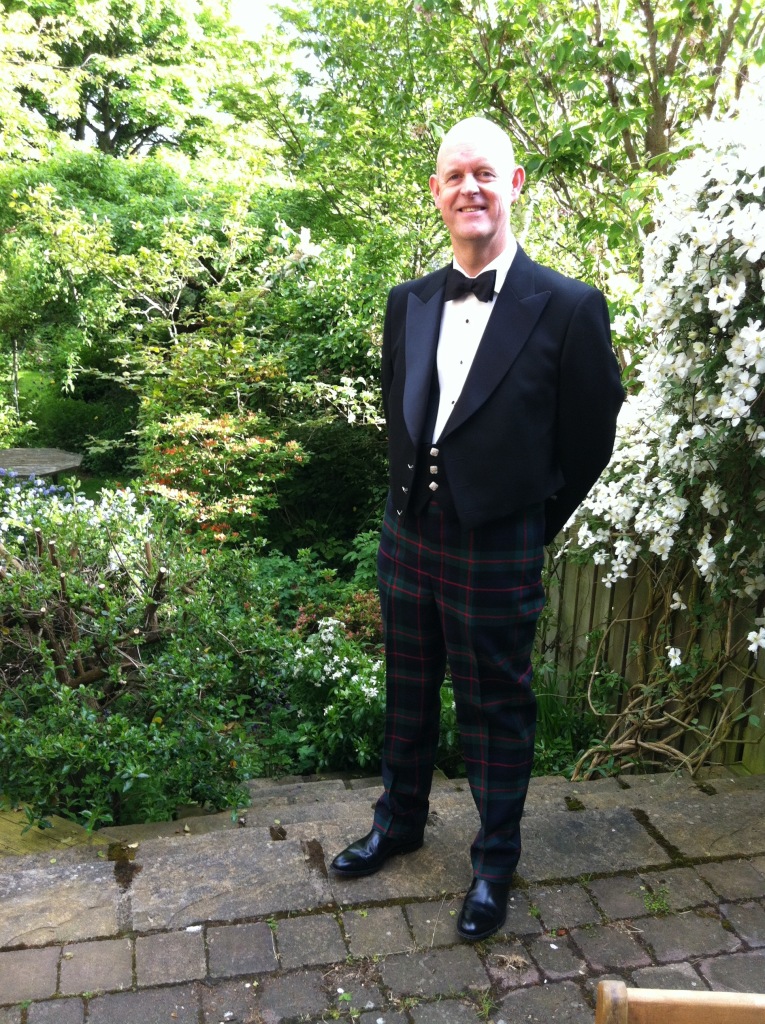
Trews with their military connotations are not favoured by the more vehement supporters of Scottish Independence – another good reason to wear them. The bitter division of Scots into pro- and anti-independence camps over this issue has been disturbing and has created an unpleasant atmosphere somewhat akin to the Jacobite Rebellion. At social occasions the topic is taboo if you are unaware of a person’s affiliation – and also frequently when you are. This loss of national unity in Scotland is regrettable and shows no signs of abating. The whole thing has put me off wearing the kilt. To some, that makes me the wrong sort of Scotsman.
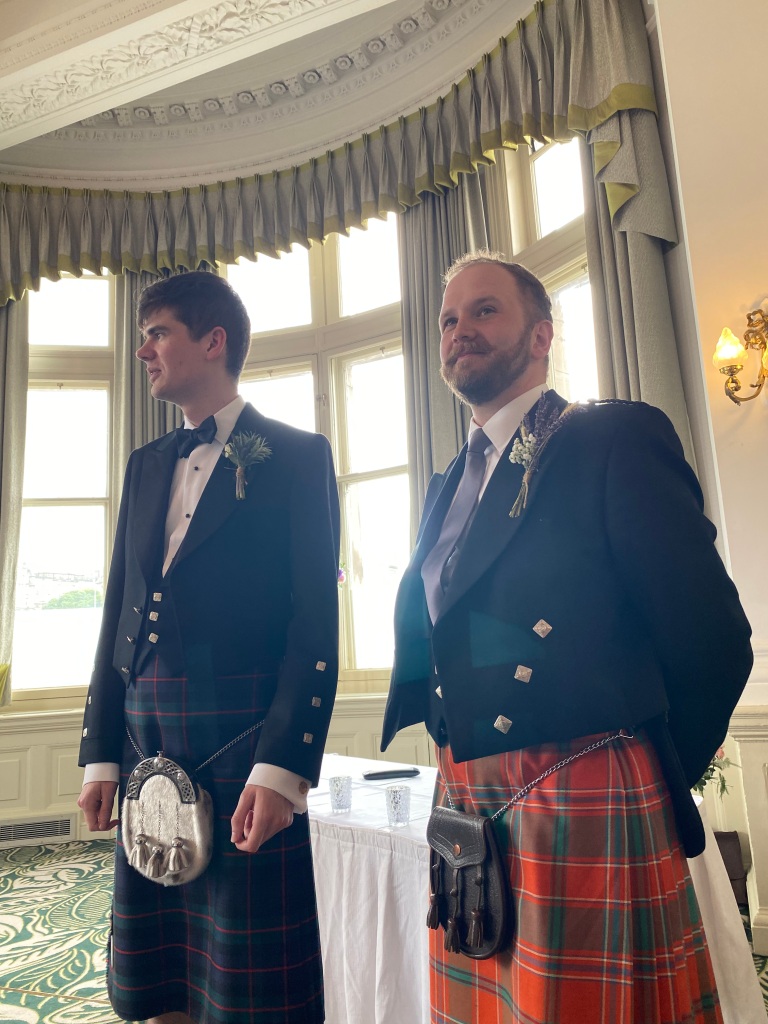
The wearing of kilts by just about every male attending a Scottish wedding continues. Recently my son married a girl from Cornwall. I took him to Kinloch Anderson to get him measured for his and all the Scots men wore kilts on the day. Shortly after that, a Scottish friend’s daughter married a boy from Birmingham and all the English lads hired kilts for the day. All things must pass and perhaps the obsession with national identity will recede and we will return to some sort of international outlook on life. In the meantime we seem doomed to an endless spiral of division into smaller and smaller-minded groups.
At school I spoke broad Ayrshire dialect, totally at odds with how we spoke at home, but one did not want to stand out from the crowd. There are movements to elevate these dialects to create some kind of linguistic chimera, despite Scots English having fragmented into disparate regional dialects hundreds of years ago. A lingua artificialis perhaps to go with the Gaelic signage sprouting up over lowland Scotland. Who knows, it may soon be necessary to speak Scots and wear lowland Scottish dress to identify with your true heritage. Get out your hodden grey plaidies boys…
